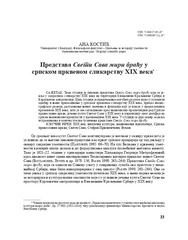Prikaz osnovnih podataka o dokumentu
Predstava Sveti Sava miri braću u srpskom crkvenom slikarstvu XIX veka
Depiction of St. Sava reconciles his brothers in the Serbian 19th century church painting
| dc.creator | Kostić, Ana | |
| dc.date.accessioned | 2021-10-12T11:50:28Z | |
| dc.date.available | 2021-10-12T11:50:28Z | |
| dc.date.issued | 2013 | |
| dc.identifier.issn | 0352-6844 | |
| dc.identifier.uri | http://reff.f.bg.ac.rs/handle/123456789/1708 | |
| dc.description.abstract | Tema studije je likovna predstava Sveti Sava miri braću koja se javlja u sakralnom slikarstvu XIX veka na teritoriji Kneževine/Kraljevine Srbije i Karlovačke mitropolije. Cilj studije je predočavanje mogućih razloga koji su uslovili odabir i njeno prikazivanje u srpskom crkvenom slikarstvu XlX veka, prikaz ikonografskog razvoja, razumevanje njenog značenja i funkcije koju je imala u pravoslavnim hramovima XlX veka, što je sve sagledavano kroz nacionalno-propagandni rad Srpske pravoslavne crkve, jačanje kulta Svetog Save u XIX veku i percepciju ovog događaja iz srpske nacionalne prošlosti u propovedima XIX veka. U studiji se daje okvir za dalja istraživanja i kontekstualna tumačenja predstave Sveti Sava miri braću. | sr |
| dc.description.abstract | As one of important national institutions, the church found in the medieval past elements to confirm their continuity, the grounds of legitimacy and the arguments of their activities with reference to the figure of the first Serbian archbishop, St. Sava. Although St. Sava was respected in earlier times his cult rose in the 19th century when he was seen not only as saint but also as national hero. The national cult of St. Sava enabled an appropriate production of visual arts and the formulation of relevant subjects, one of the most important being a scene St. Sava reconciles his brothers Stefan and Vukan. Literary sources important for the iconography development of this scene were the medieval lives of St. Sava (by Theodosius, Domentian, Stephan the Firstcrowned), theological literature (especially 19th century sermons) and 19th century histories. By depicting this scene in the temples on the territory of Vojvodina and the Kingdom of Serbia, numerous painters such as Arsenije Teodorović, Pavle Simić, Stevan Todorović, Milija Marković, Pasko Vučetić and Paja Jovanović gave their own contribution to its iconography and pictorial poetics. As icons from the Bishop's thrones and iconostases, or as frescoes from the walls of numerous churches, depictions of St. Sava reconciles his brothers Stefan and Vukan had a special relation to the believers. It was a positive example from the national past which the church used as a visual form for sending a moral-didactic message about the importance of brotherly love and unity for the progress of the Serbian nation and state. On the other hand, the depictions of St. Sava reconciles his brothers Stefan and Vukan functioned as an example of Christian virtues such as love of one's neighbor, respect for authority and forgiveness that were presented visually through the personas of St. Sava, Stefan and Vukan. In both cases, the church used this event from the national medieval past to shape the reality of the nation and thus ensure its future life, which was all in accordance with its national propaganda work in the 19th century. The depictions of St. Sava reconciles his brothers Stefan and Vukan was used by the high church hierarchy to highlight the importance of bishops in the life of the Serbian people, but this scene was also an historical foundation for political action of Serbian bishops in the 19th century. | en |
| dc.publisher | Matica srpska, Novi Sad | |
| dc.relation | info:eu-repo/grantAgreement/MESTD/Basic Research (BR or ON)/177001/RS// | |
| dc.rights | openAccess | |
| dc.source | Zbornik Matice srpske za likovne umetnosti | |
| dc.subject | XlX vek | sr |
| dc.subject | Vukan | sr |
| dc.subject | vizuelna kultura | sr |
| dc.subject | Sveti Sava | sr |
| dc.subject | Stefan Prvovenčani | sr |
| dc.subject | Srpska pravoslavna crkva | sr |
| dc.subject | nacionalna ideologija | sr |
| dc.title | Predstava Sveti Sava miri braću u srpskom crkvenom slikarstvu XIX veka | sr |
| dc.title | Depiction of St. Sava reconciles his brothers in the Serbian 19th century church painting | en |
| dc.type | article | |
| dc.rights.license | ARR | |
| dc.citation.epage | 49 | |
| dc.citation.issue | 41 | |
| dc.citation.other | (41): 33-49 | |
| dc.citation.rank | M51 | |
| dc.citation.spage | 33 | |
| dc.identifier.fulltext | http://reff.f.bg.ac.rs/bitstream/id/598/1705.pdf | |
| dc.identifier.rcub | https://hdl.handle.net/21.15107/rcub_reff_1708 | |
| dc.type.version | publishedVersion |

